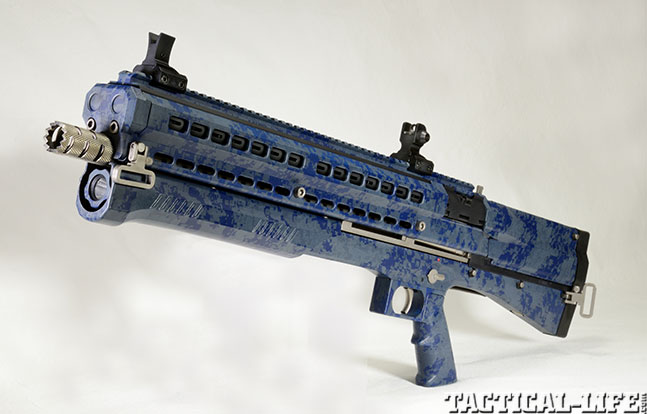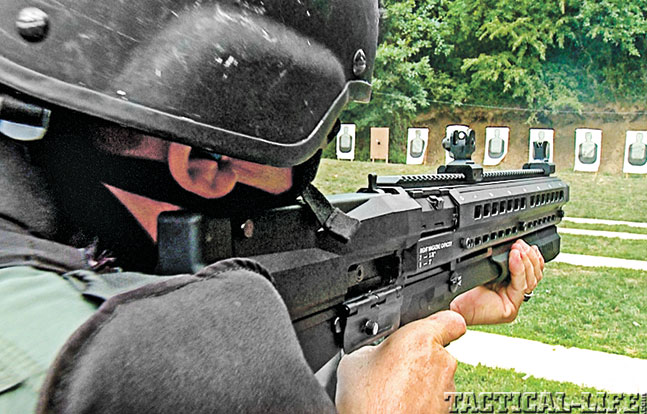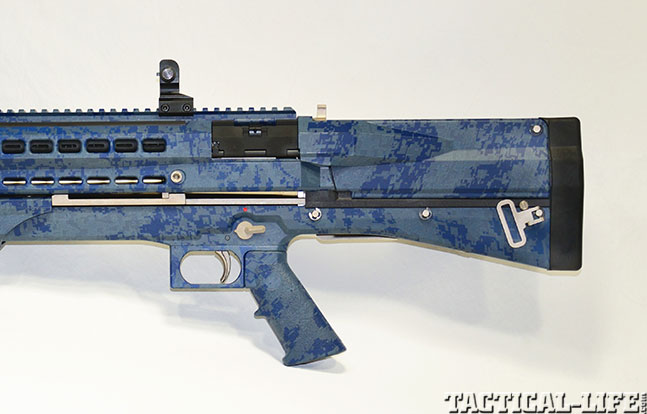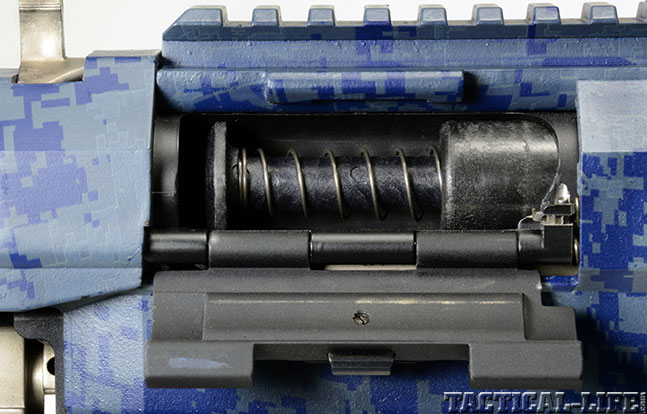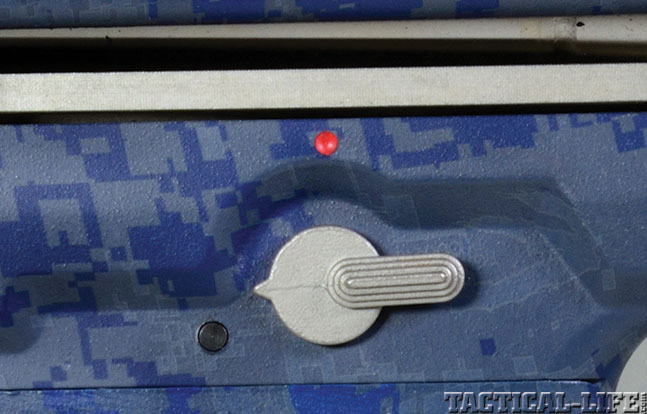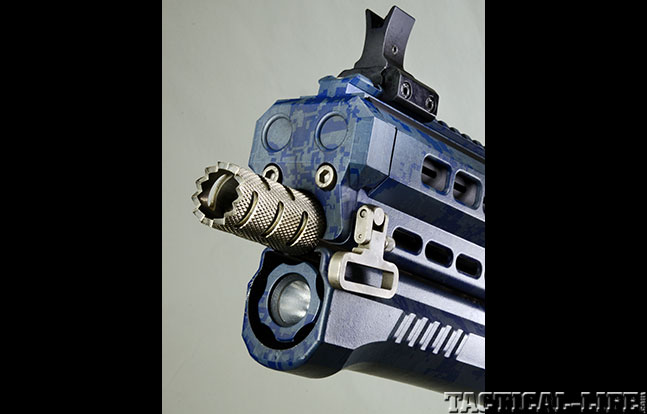Warships have a wide array of weapons that can be used against attackers, but merchant ships and private yachts are far more limited. Let me add the caveat that when I was doing private protective work I saw yachts equipped with heavy machine guns that could chop most attacking craft to pieces, but that was the exception.
- RELATED: Top 6 Shotguns From GUNS & WEAPONS FOR LAW ENFORCEMENT in 2014
- RELATED VIDEO: UTS-15 Bullpup Tactical 12 Gauge Shotgun
Normally, the merchant vessel or yacht will rely on three types of weapons to counter attackers. Instead of the machine gun, an anti-materiel rifle such as a Barrett .50 can be used to keep attackers at a distance by targeting their engine, hull or other vulnerable areas. Wind can affect the point of impact substantially at sea, so a heavier bullet is better as well. Personnel can also be picked off at a distance. In this scenario, shooters usually find a good shooting position that is least sensitive to the ship’s movement and allows them to fire from a rest or bipod for such longer-range shooting.
For engaging pirates as they approach a vessel, a select-fire battle rifle becomes more useful for providing continuous fire. Although the M4 seems to be widely used, I normally recommend one of the AR-type rifles in .308 Winchester/7.62mm NATO for greater striking power and to do more damage to the pirate craft. Normally, to allow for movement of the two vessels, body shots on the pirates are preferable.
Advertisement — Continue Reading Below
Finally, to actually engage pirates who are boarding or have boarded the ship or yacht, the shotgun is very useful. Not only does it unleash a lot of lethal buckshot fast, but the shotgun will be less likely to damage critical gear aboard the vessel being defended. The primary problem with shotguns used in maritime security, however, is magazine capacity. After the order to “Repel boarders!” there isn’t a lot of time for reloads. That’s where the UTS-15 Marine from UTAS becomes relevant.
Ocean Thunder
The UTS-15 takes its designation from its joint design/production origins—“U” for U.S.A., where it was designed by Ted Hatfield, and “T” for Turkey, where some of the parts are manufactured. The “S” is for shotgun, and the “15” represents the cartridge capacity. And cartridge capacity is one of the big selling points for the UTS-15. Let me digress on that point for a minute. Traditionally, higher cartridge capacity for shotguns has meant longer tubes and longer barrels. Hence, higher cartridge capacity has meant less handiness. Box-magazine-fed shotguns can have shorter barrels, but to get even a seven- or eight-round capacity, the magazine becomes so long that it will catch on doorways or other projections. Drums for shotguns can increase cartridge capacity without becom-ing too unwieldy. Currently, though, the solution that combines cartridge capacity with handiness best is the use of multiple tubes.
Advertisement — Continue Reading Below
“I fired two rounds of Federal’s 3-inch #4 buckshot, which chopped up an OPSGEAR Osombie target really well with a pattern measuring 12.25 by 13.5 inches.”
That’s what the UTS-15 does. It has twin feed tubes combined with what appears to be a bullpup design. I say “appears to be” because, by definition, a bullpup rifle has the action and magazine behind the trigger group. That is not the case with the UTS-15, as the magazine tubes are forward. But it looks and handles much as a bullpup.
With the UTS-15 feed system, each of the dual feed tubes, which are located above and on each side of the bore, holds seven 2¾-inch shells or six 3-inch shells. There is a selector lever atop the shotgun that can be set in the middle to allow alternate feeding from each tube or on the right or left sides to feed only from that tube. Using the selector to feed from only one tube at a time allows you to load one tube with buckshot and the other with slugs or some other combination. Loading is accomplished via two ports, one on each side. You open the loading port cover and push the follower forward against a spring to lock it in place while shells are loaded. When the port is closed, a shell pops back into the loading chamber ready to feed. If the full 15-round capacity is desired, after the first shell is loaded, that tube may be topped off.
Advertisement — Continue Reading Below
Unlike some of the other high-capacity, multiple-tube shotguns, the UTS-15 is a pump action. As with any pump shotgun, it is important to operate the action fully by pulling it to the rear smartly and thrusting it forward smartly to feed the shell and lock the action. When using 3-inch shells I found it especially important to pull the forearm back smartly to ensure ejection of the spent shell.
Because of the relatively complicated loading drill, checking that the UTS-15 is unloaded requires a couple of extra operations. First, the action should be opened and the chamber checked to be empty. Then, each of the loading port doors should be opened to check that the loading chambers are empty. Finally, the top of the stock may be opened to look once again to ensure that a round is not present anywhere in the action. It’s easier and faster than it sounds. Opening the top of the stock also allows easy access to clear a malfunction should one occur.
Range Ready
Advertisement — Continue Reading Below
The barrel is threaded to accept chokes designed for Beretta shotguns, allowing some choice in what choke to use with the UTS-15. It comes standard with a cylinder-bore choke that fits flush inside the barrel. However, I chose the optional ported cylinder-bore breaching choke, to be honest, because I like the way it looks. UTAS recommends against firing the UTS-15 without a choke in place.
The UTS-15’s controls are quite ergonomic. The safety is on the left side of the receiver like an AR-15’s, and it operates similarly. On the right side of the receiver is another switch that operates the green laser/white light located under the barrel. Down turns on just the laser and up activates both the white light and laser. This laser can be adjusted for both windage and elevation with an Allen wrench, but the white light itself cannot be adjusted. On the bottom of the synthetic stock is a button that releases the slide manually. A flip-up dust cover similar to an AR-15’s is on the right side of the receiver. I would recommend keeping it closed to keep debris, dust, etc., from getting into the action. The triggerguard has also been squared and is large enough for operators to use the shotgun while wearing gloves.
A Picatinny top rail allows users to mount optics and sights. I usually use a red dot, often one of the miniature models, on shotguns, but the optional iron sights for the UTS-15 are sufficient, so I used them for all of my testing. The rear has a flip-up ghost ring/V-notch that is adjustable for windage. Since I use ghost-ring sights on a lot of my shotguns, I chose that option. The front post sight is adjustable for elevation. After firing only three patterns, I had them adjusted for 25 yards.
Advertisement — Continue Reading Below
The UTS-15 has a well-designed pistol grip with finger grooves. Generally, bullpup-type weapons do not lend themselves well to extensive carry, though the pistol grip helps. The UTS-15 has sturdy sling swivels mounted on the side.
Rounds Downrange
So far I’ve fired over 90 rounds through the UTS-15 in three sessions. I used Winchester GI overrun 00 buckshot, Federal Tactical low-recoil 00 and #4 buckshot, Winchester low-recoil 00 and #4 buckshot—all in 2¾-inch shells. I also used 3-inch Federal #4 buckshot.
Advertisement — Continue Reading Below
I used an assortment of targets—some zombies, since we know fast-firing shotguns are good zombie killers—and some bad guys with guns. I started off firing 2¾-inch Winchester low-recoil 00 buckshot at 15 yards. For my testing I wanted to see how fast loading from alternate tubes was, so I fired two rounds with the selector set in the center for dual feeding. The two rounds on a zombie target were low, but the pattern was good and would have chopped the zombie into two half-zombies.
Also at 15 yards, I fired two rounds of Federal’s 3-inch #4 buckshot, which chopped up an OPSGEAR Osombie target really well with a pattern measuring 12.25 by 13.5 inches. I had adjusted for windage and elevation prior to firing these rounds, so the pattern was well centered in the chest.
At 25 yards, I tried two rounds of Federal’s 2¾-inch Tactical #4 buckshot on an OPSGEAR bad guy with a gun target. The pattern was a little to the left but only stretched 14 inches. I adjusted the windage an additional two clicks, and the second pattern at 25 yards was well centered.
Advertisement — Continue Reading Below
In addition to firing half a dozen patterns on paper, I fired another 80 to 90 rounds at plates at distances from 15 to 35 yards to evaluate the UTS-15’s handling. I mostly fired with the selector set to alternate barrels, but I did do a couple of runs with it set to feed from the right tube, then shifted to the left tube when it was empty. It was a bright sunny day, so I did not get a chance to figure out the laser’s point of impact. The trigger pull was pretty good, which means that I did not notice it being especially heavy. Of course, as expected, the recoil was light given the low-recoil loads. There was more recoil with the 3-inch loads, but shooting wasn’t uncomfortable. I like the sights. They are easy to acquire and can be readily adjusted. Windage is click adjustable and elevation can be adjusted by inserting a screwdriver in the slot atop the front post. As I mentioned earlier, it is important with the UTS-15 shotgun to work the slide with some force when pulling the forearm back and pushing it forward to ensure optimum reliability. This is especially true if you’re working with 3-inch shells.
More Firepower
The UTS-15 Marine is definitely distinctive. For those who want a less “distinctive” look than the model I tested, the UTS-15 is available in black, olive drab, Flat Dark Earth/desert and some other finishes. With an MSRP of $1,650, the UTS-15 is not a cheap shotgun, but it is a lot of shotgun for the price.
Advertisement — Continue Reading Below
For more information, visit utas-usa.com or call 847-768-1011.
